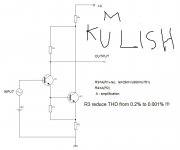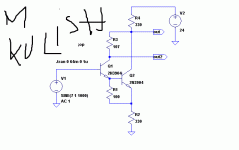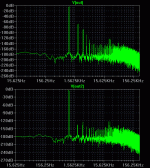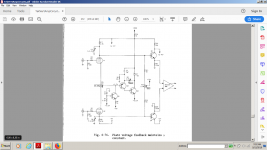. A bipolar first device in a phono preamp can cause current to circulate in the phono cartridge, so a DC blocking cap should be used on the input.
.
If you use SET input topology, thats true. But then the distortion is higher also.
If you use compliementary push-pull input the base currents cancel and no coupling cap is needed.
THx-RNMarsh
Richard, you are not 'pushing' your preamp to show its TRUE distortion spectrum. You are measuring too low in signal level.
You still dont get it. Or pretend not to? Not too sure how practical/scale-able up to power amp levels use it would be.
Unless, you are making SET amplifiers, fets offer no advantage for audio performance. Measured or subjective.
So, if JC amps consistently are rated more accurate (?) sounding it probably is due to a number of other things besides just using fets.
??
THx-RNMarsh
This has been my experience.
In fact in most cases I have found BJT's to sound and measure superior to
Fets but there is a LOT in the subtleties of how to use them properly -
especially if you are using no / low feedback.
T
Bipolars only really excel when running in CURRENT MODE. This is because the non-linear exponential characteristic of the bipolar is CANCELLED by the 'diode' distortion input.
Richard, you must read a book on this, or an equivalent lecture to understand that fets are INHERENTLY more linear than bipolar, BUT less linear than tubes. It is in the fundamental equations and the distortion predictions from these equations. IF you drive your original circuit hard enough, you will see higher order distortions.
Richard, you must read a book on this, or an equivalent lecture to understand that fets are INHERENTLY more linear than bipolar, BUT less linear than tubes. It is in the fundamental equations and the distortion predictions from these equations. IF you drive your original circuit hard enough, you will see higher order distortions.
Bipolars only really excel when running in CURRENT MODE. This is because the non-linear exponential characteristic of the bipolar is CANCELLED by the 'diode' distortion input.
Richard, you must read a book on this, or an equivalent lecture to understand that fets are INHERENTLY more linear than bipolar, BUT less linear than tubes. It is in the fundamental equations and the distortion predictions from these equations. IF you drive your original circuit hard enough, you will see higher order distortions.
You told me this 40 years ago. I just dont see it's inherent superiority as a practical matter though.
Yes, I am sure as I get closer to clipping that i will see odd harmonics start to show up. How much harder? I am running original +/- 24vdc.
I run output to 2.5 v rms and see still no 5,7,9 11 etc. Which is my point.
Do I need to go higher output than DAC normal output levels or PA normal max input drive?
THx-Richard
Last edited:
Richard, you are not 'pushing' your preamp to show its TRUE distortion spectrum. You are measuring too low in signal level.
This is not my cascoded version et al. But increasing from 1v rms to 3 v rms and 20KHz (no filters applied) the harmonics are still below -100 un-trimmed/ 20% matched version.
How hot should I be driving it ?
Its late. I will see all the harmonics when I get closer to clipping. But for all practical purposes at normal max output levels, well below clipping, the 2H and 3H from all bipolar only dominate here..
Later.
-Richard
Last edited:
Bipolars only really excel when running in CURRENT MODE. This is because the non-linear exponential characteristic of the bipolar is CANCELLED by the 'diode' distortion input.
I found this over in the SS forum, around a half dozen threads related to it. In one thread it was suggested that this was an old tube circuit, but they never produced any evidence of that. Anyway, it provides around a 100X improvement in distortion over a single device. Only uses two devices. (Looks similar to a Darlington) Works with all N type devices, including tubes. It uses feedforward error correction rather than feedback. And it functions as a V to I converter, but is suitable for driving a cascode above it for V to V use. Still trying to get a clear picture in my mind how it works so well, but supposedly the second device is adding opposite distortion of the first device, so cancelling. Zo = R3+R4. Gain == R4/R2 (for Rload >> R3+R4)
R3 has to be critically adjusted for linearity. For gain of 3 in post #27 circuit: R1 100 Ohm, R2 332 Ohm, R3 318 Ohm, R4 1000 Ohm. More info and a diagram in the link:
Kulish Circuit
Single darlington line preamp. - Page 3 - diyAudio
Kulish Circuit
https://www.diyaudio.com/forums/solid-state/74861-single-darlington-line-preamp-3.html#post857018
I am producing that evidence now in the attachment.Tektronix used bipolar transistors to cancel tube distortions...
For every poison there's a cure.
Attachments
Last edited:
..... One could call some things 'nearing the best anyone knows how to do at this point,' .....
SOTA is the best term?
You still dont get it. Or pretend not to? Not too sure how practical/scale-able up to power amp levels use it would be.
Unless, you are making SET amplifiers, fets offer no advantage for audio performance. Measured or subjective.
So, if JC amps consistently are rated more accurate (?) sounding it probably is due to a number of other things besides just using fets.
??
THx-RNMarsh
Are they rated accurate really? I thought they where "preferred"?
//
AES talk on how we hear....
Shows why an engineer shouldn't be lecturing on cognitive psychology.
Mark Levinson Audio System ML-2
American Renaissance
The little-known and underrated Hadley Laboratories 622C aside, the John Curl designed ML-2 was the first solid-state amp to put the transistor on an equal footing with the tube. It featured Curl’s JFET complementary differential input stage, a circuit so remarkable that it would soon become a staple of virtually all high-end amplifiers (and remains so to this day). Introduced in 1977, these 25W Class A monoblocks (50W into 4 ohms, 100W into 2 ohms) from Mark Levinson Audio Systems set a new standard of clarity, liquidity, timbral beauty, and three-dimensional imaging and soundstaging for solid-state. The polar opposite of the grainy, piercing, high-in-odd-order-harmonics sound that many of us then associated with solid-state designs, the ML-2 proved that the transistor could make music as readily as it could generate power. The ML-2 gave new meaning to the word “transparency,” and set a benchmark against which all subsequent solid-state amplifiers were judged. Perhaps more than any other single product, the ML-2 exemplified, in performance and build-quality, the vanguard of the American high-end renaissance. Today, the ML-2 is the most collectable of all solid-state amplifiers.
I have to think that FET's played a big part of this amps sound. This quote is from The Absolute Sound magazine.
American Renaissance
The little-known and underrated Hadley Laboratories 622C aside, the John Curl designed ML-2 was the first solid-state amp to put the transistor on an equal footing with the tube. It featured Curl’s JFET complementary differential input stage, a circuit so remarkable that it would soon become a staple of virtually all high-end amplifiers (and remains so to this day). Introduced in 1977, these 25W Class A monoblocks (50W into 4 ohms, 100W into 2 ohms) from Mark Levinson Audio Systems set a new standard of clarity, liquidity, timbral beauty, and three-dimensional imaging and soundstaging for solid-state. The polar opposite of the grainy, piercing, high-in-odd-order-harmonics sound that many of us then associated with solid-state designs, the ML-2 proved that the transistor could make music as readily as it could generate power. The ML-2 gave new meaning to the word “transparency,” and set a benchmark against which all subsequent solid-state amplifiers were judged. Perhaps more than any other single product, the ML-2 exemplified, in performance and build-quality, the vanguard of the American high-end renaissance. Today, the ML-2 is the most collectable of all solid-state amplifiers.
I have to think that FET's played a big part of this amps sound. This quote is from The Absolute Sound magazine.
Shows why an engineer shouldn't be lecturing on cognitive psychology.
How so JJ's fairly highly respected in perceptual end of the field?
How so JJ's fairly highly respected in perceptual end of the field?
I would like to have a sit down talk with him about his responses to questions at the end. First of all 'expectation' as shown in the slide is the wrong word, it should probably be 'primed.' Second, people don't miss the gorilla in the movie 'because they weren't expecting it', they missed it because they had been given a cognitive loading task to do while watching the basketball game. That is to say, they missed the gorilla because of distraction caused by cognitive loading (same type of thing that makes ABX an insensitive test for showing detection of small differences, IMHO).
Last edited:
Mark Levinson Audio System ML-2
American Renaissance
The polar opposite of the grainy, piercing, high-in-odd-order-harmonics sound that many of us then associated with solid-state designs, the ML-2 proved that the transistor could make music as readily as it could generate power.
.
Yes, no argument about the sound of early SS amps producing a lot of odd harmonics are NFG for accuracy. Just FETs are not the only one's any more. Fets are still doing a great job.
However, many newer designs do as well using bipolar. Esp some of the CMA circuits and also DIYAudio's DADod's circuit for example. All bipolar except OPS.
THx-RNMarsh
Last edited:
I would like to have a sit down talk with him about his responses to questions at the end. First of all 'expectation' as shown in the slide is the wrong word, it should probably be 'primed.' Second, people don't miss the gorilla in the movie 'because they weren't expecting it', they missed it because they had been given a cognitive loading task to do while watching the basketball game. That is to say, they missed the gorilla because of distraction caused by cognitive loading (same type of thing that makes ABX an insensitive test for showing detection of small differences, IMHO).
..that is a theory, not a fact. We don't know enough to really now why the gorilla is missed. Cog Psych is still very much a work in progress.
- Status
- Not open for further replies.
- Home
- Member Areas
- The Lounge
- John Curl's Blowtorch preamplifier part III



